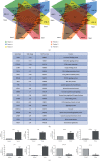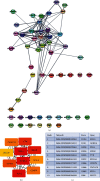Identification of Differentially Expressed Genes in Cervical Cancer Patients by Comparative Transcriptome Analysis
- PMID: 33829064
- PMCID: PMC8004372
- DOI: 10.1155/2021/8810074
Identification of Differentially Expressed Genes in Cervical Cancer Patients by Comparative Transcriptome Analysis
Abstract
Cervical cancer is one of the most malignant reproductive diseases seen in women worldwide. The identification of dysregulated genes in clinical samples of cervical cancer may pave the way for development of better prognostic markers and therapeutic targets. To identify the dysregulated genes (DEGs), we have retrospectively collected 10 biopsies, seven from cervical cancer patients and three from normal subjects who underwent a hysterectomy. Total RNA isolated from biopsies was subjected to microarray analysis using the human Clariom D Affymetrix platform. Based on the results of principal component analysis (PCA), only eight samples are qualified for further studies; GO and KEGG were used to identify the key genes and were compared with TCGA and GEO datasets. Identified genes were further validated by quantitative real-time PCR and receiver operating characteristic (ROC) curves, and the highest Youden index was calculated in order to evaluate cutoff points (COPs) that allowed distinguishing of tissue samples of cervical squamous carcinoma patients from those of healthy individuals. By comparative microarray analysis, a total of 108 genes common across the six patients' samples were chosen; among these, 78 genes were upregulated and 26 genes were downregulated. The key genes identified were SPP1, LYN, ARRB2, COL6A3, FOXM1, CCL21, TTK, and MELK. Based on their relative expression, the genes were ordered as follows: TTK > ARRB2 > SPP1 > FOXM1 > LYN > MELK > CCL21 > COL6A3; this generated data is in sync with the TCGA datasets, except for ARRB2. Protein-protein interaction network analysis revealed that TTK and MELK are closely associated with SMC4, AURKA, PLK4, and KIF18A. The candidate genes SPP1, FOXM1, LYN, COL6A3, CCL21, TTK and MELK at mRNA level, emerge as promising candidate markers for cervical cancer prognosis and also emerge as potential therapeutic drug targets.
Copyright © 2021 Annapurna S. D. et al.
Conflict of interest statement
All authors declare that there are no conflicting interests.
Figures






References
-
- Giftson Senapathy J., Umadevi P., Kannika P. S. The present scenario of cervical cancer control and HPV epidemiology in India: an outline. The Asian Pacific Journal of Cancer Prevention. 2011;12:1107–1115. - PubMed
-
- Bruni I., Albero G., Serrano B., et al. ICO/IARC Information Centre on HPV and Cancer (HPV Information Centre) Human Papillomavirus and Related Diseases in India; 2019.
Publication types
MeSH terms
LinkOut - more resources
Full Text Sources
Other Literature Sources
Medical
Molecular Biology Databases
Research Materials
Miscellaneous

